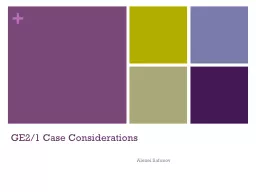

Alexei Safonov CMS Muon Upgrades CMS Technical Proposal in its part related to muon systems lists following MEX1 electronics upgrade needed to keep up with L1 rate and latency GE11 detector early Phase2 to aid forward ID: 781161
Download The PPT/PDF document "GE2/1 Case Considerations" is the property of its rightful owner. Permission is granted to download and print the materials on this web site for personal, non-commercial use only, and to display it on your personal computer provided you do not modify the materials and that you retain all copyright notices contained in the materials. By downloading content from our website, you accept the terms of this agreement.
Slide1
GE2/1 Case Considerations
Alexei
Safonov
Slide2CMS Muon Upgrades
CMS Technical Proposal in its part related to
muon
systems lists following:MEX/1 electronics upgrade (needed to keep up with L1 rate and latencyGE1/1 detector (“early Phase-2” to aid forward muon trigger) & a matching GE2/1 (regular Phase-2)GE0/1 detector (extends offline coverage beyond h=2.4, a.k.a. ME0)
RPC stations 3/1 and 4/1 (based on improved technology)DT mini-crates
2
Slide3GE2/1: Local Reconstruction
Helps improve local stub-reconstruction efficiency in station 2
Without it, local stub reconstruction inefficiency due to CSC HV spacers
Overall increase in efficiency due to requiring 3 hits instead of 4 if GEM hits are presentCant drop it in near stations as without an extra confirmation as neutron backgrounds can increase
3
Slide4GE2/1: L1 Muon Track Reconstruction
Better
local reconstruction propagates into higher efficiency for Track Finding
Here, we use 3+ stub configuration, which is the tighter option leading to low trigger rate (assume we are considering up to 200 PU)Caveat: below plots also include RE3/1-4/1, but with CSC 3 hit requirement in far stations we only lose 1% in plateau if RE3/1 and RE4/1 are disabledEffect on trigger rate is limited: even without GE1/1, on itself GE2/1 rate reduction is less than x1.5-2 (limited by ME2/1 resolution at L1)
4
Slide5Muon Triggering at HL-LHC
Tracking trigger will help tremendously for the entire physics program
Matching
muons with tracks allows dramatic improvement in resolution and trigger rateBut… many physics models (new and old ones) predict long lived particlesHiggs portal, dark sector, new bosons, SUSY extensions, W-primes etc.CMS won’t see any of that new physics if it’s there
Tracking trigger inefficient for dxy above ~2 mm
5
Slide6Is Standalone Muon Trigger at HL-LHC Possible?
Absolutely! Even with no improvements, a
dimuon
trigger will workTake thresholds from Phase-1 L1 Upgrade Trigger TDR for 2.2x1034: pt=15 and 10 GeV yielding 10 kHz of rateGE1/1 will make it more like 7.5 kHzAt 5x10
^34 that trigger will yield a rate of ~15 kHz as all muon triggers evolve linearly
Efficient
to modestly displaced
muons
:
Studied in
the
barrel:
current
muon
trigger is efficient to
muons
with
dxy
up to ~10
cm
Beyond that the problem is in
p
T
assignmentStill beats 2mm by a large margin!So it is absolutely doable, but requires maintaining standalone muon trigger capabilities (dimuon = 2 x standalone muon)
6
Slide7Muon Trigger at HL-LHC
Current barrel
muon
trigger pT assignment is inefficient for highly displaced muonsIt finds them, but pT is measured lowImpact
parameter of ~10cm still beats 2mm by a large margin, but we may be able to do better
Study shows the problem is a consequence of the momentum measurement algorithm focusing on
absolute values of bending angles in station 1
Great for prompt
muons
, really non-optimal for displaced
muons
7
Slide8Stub Alignment Algorithm
Checks if the stubs are aligned with each other
If aligned, it’s high
pT, whether prompt or displacedFigure of merit: difference of inverse bend angles 1/
fImplies we can measure bending angles in at least some stationsNew p
T assignment works well with even a very simplistic algorithmTrigger rate (PU only) is the same as for the current algorithm
Should
decrease with adding more features to the algorithm
Gearing up for a more complete simulation
Working
on implementing
it in HLT (Sven)
Started expanding
into forward
region (Jose)
8
Slide9Bending Angles
Important for triggering on highly displaced
muons
Work well in the barrel:Thick detectors make a large lever arm, large magnetic fieldCSC
bending patterns in ME-X/2 may be sufficient as magnetic field is much larger in ME2/1 compared to ME1/1The only problem is we won’t have these studies done by the end of this Summer
Works in the very forward region
Weakened
magnetic field, but
GE1
/1 example
says
that an increased lever arm
helps
Need more than a single angle measurement (GE2/1!)
Region of eta below 1.6:
9
Slide10Further Considerations
If ME1/1 performance at HL-LHC is significantly degraded, having high efficiency in station 2 will help
GE2/1 helps increase that efficiency from 80-85% to 95%
Can be important for matching with tracking trigger tracks as GE1/1 aloneHLT uses standalone muon reconstruction in its selectionsIf ME3/1 and ME4/1 do not receive new electronics, expect decrease in reconstruction efficiencyAdditional points from GE2/1 and GE2/1-ME2/1 bending angle will help strengthening standalone muon
reconstruction in that regionAt the very least descoping both GE2/1 and ME3/1+ME4/1 in the same scenario seems worrisome
10